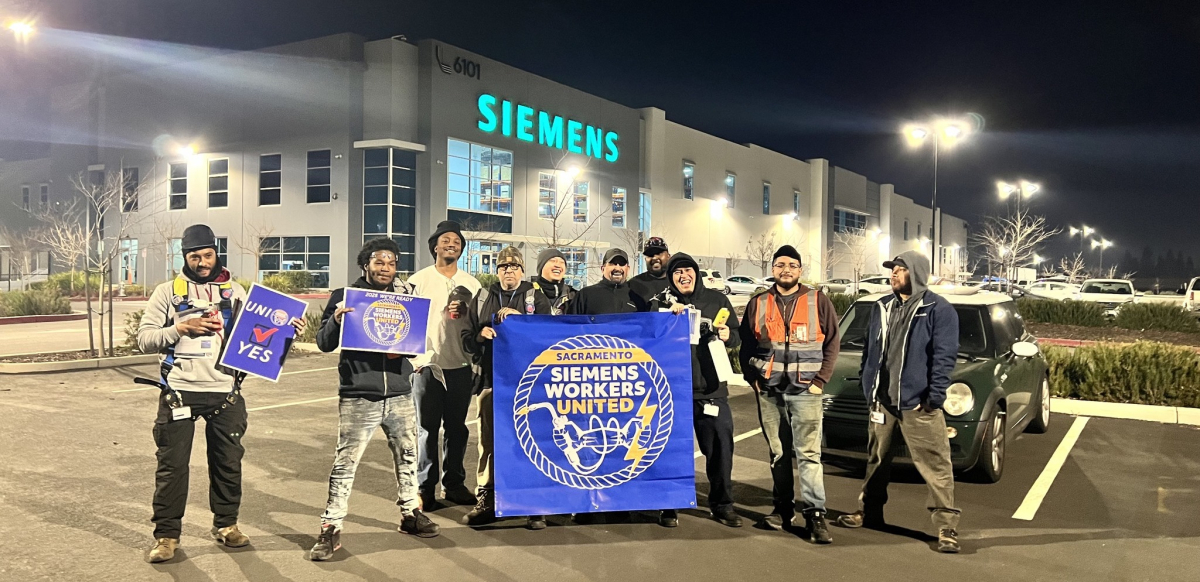Our Siemens Union Drive Lost. But We Need More Like It.

The 1,600 workers at the Siemens Sacramento facility manufacture locomotives, coaches, and light rail trains. A joint campaign by the IBEW and the Boilermakers to organize the plant came up short earlier this year. Photo: Siemens Workers United
Workers at the Siemens Mobility manufacturing plant in Sacramento, where I worked, lost a unionization election in March, 838 to 538. While the result was disappointing, the joint campaign by Electrical Workers (IBEW) Local 1245 and the Boilermakers represents the kind of organizing that the labor movement should double down on to reverse the tide of declining density in the private sector.
Since 2019, elections covering units of more than 1,000 workers have accounted for less than 1 percent of those carried out through the National Labor Relations Board, and most of these have been in health care and higher education.
The Biden-era economic agenda featured significant investment in passenger rail as part of a broader domestic investment in green manufacturing. Despite attacks on industries like solar and wind, Siemens, headquartered in Germany and one of the world’s largest manufacturers, is set to earn big profits from state-led investments in the green economy.
Siemens has a $7.3 billion contract with Amtrak to build new locomotives and coaches in North America, and is one of two companies competing to build and maintain the state’s high-speed rail trains. The company also won a contract in 2024 to build high-speed trains for the Brightline West system, which will be produced at a new Siemens facility in Horseheads, New York.
Sacramento has long been Siemens’ only train factory in North America. The 1,600 workers here manufacture locomotives, coaches, and light rail trains. In 2023, Siemens announced it was building a second facility to manufacture passenger coaches in Lexington, North Carolina. The Horseheads plant in New York will be the third, and will manufacture high-speed trains.
While Siemens profits from billions of dollars in taxpayer contracts, it produces these multi-million-dollar trains using a low-wage business model, and was accused of violating labor law and international agreements to defeat the union at its flagship train manufacturing facility.
A BIG, DIVIDED WORKFORCE
Wages and the merit-based raise system were key issues in the Siemens Workers United campaign. At the time I was hired in 2023, the starting wage was $17.50. Meanwhile we were producing locomotives worth $10 million each.
After the union campaign kicked off, with the California fast food worker minimum wage about to rise to $20, the company raised its starting wage to $20. But in a sign of disrespect, it gave this raise only to starting level wages, denying longtime employees similar raises. Some workers in the plant were still making only $24 after working there for 14 years; their only raises came from “merit” reviews based more on manager favoritism than the quality of their work.
To maintain its low-wage business model, Siemens relies heavily on immigrant workers with limited job opportunities. Many of the longest-tenured workers were immigrants from Russia, Ukraine, and Vietnam; newly hired workers were predominantly Afghan refugees and Filipinos.
Siemens placed hiring decisions in the hands of front-line managers who relied heavily on word-of-mouth recruitment, producing departments that were often highly segmented along ethnic and racial lines. Latinos were concentrated in the paint department; Hmong, Filipino, and Vietnamese workers in subassembly.
These divisions and the large workforce created high barriers to organizing, thwarting earlier attempts to organize with the Communication Workers (CWA) and the IBEW. The latest campaign, which started in early 2023, was the most successful to date, even though it fell short.
ANTI-UNION CAMPAIGN TOO MUCH

SUPPORT LABOR NOTES
BECOME A MONTHLY DONOR
Give $10 a month or more and get our "Fight the Boss, Build the Union" T-shirt.
The biggest challenge was the size of the bargaining unit. The California Federation of Labor Unions and the Sacramento Central Labor Council helped by providing support for doorknocking blitzes. When we reached workers at home, face to face, a supermajority supported unionization. And we were able to build strong majority support in some departments.
But in the end, Siemen’s anti-union campaign was too much. Workers we couldn’t reach directly at work or at home instead learned about the campaign from managers, and they were scared by the typical anti-union talking points.
A 2023 International Framework Agreement and memorandum of understanding between the company and unions, including the IBEW and Boilermakers, was supposed to limit what language management could use to attack the union. But local management immediately violated the agreement by holding captive-audience meetings, which were later banned by California state law as of January 1, and portraying the union campaign as a “third party.”
To make matters worse, Siemens held training sessions for frontline managers where the company claimed it would have to think about moving production out of Sacramento if the plant unionized. The managers then spread the word with group leads—non-managerial entry-level workers with limited supervisory responsibilities—who immediately spread the word to anyone interested in forming a union. These threats were more credible given the company’s North Carolina plant had just recently opened.
Managers also openly spread rumors that unionization would lead to a loss of benefits and changes to scheduling. One particularly dishonest threat was that workers would not have as much opportunity for overtime if they unionized. For many workers this overtime is a crucial lifeline to afford life in Sacramento—but only because Siemens pays such low wages.
Towards the end of the campaign, I would hear from workers on the phone that they knew they weren’t getting their fair share from Siemens, but they weren’t convinced they had the power to win a better deal. Since we rarely experienced our collective power firsthand, the company’s threats were more convincing than my personal anecdotes about how direct action had won demands in previous jobs.
IT TAKES A FEW TRIES
The stakes of the current moment are too high to linger in discouragement from this loss. Manufacturing in the U.S. continues to play a key role in global production, second only to China in total output, and dominates our political discourse. More unions should take the risk of supporting workers to organize big workplaces in manufacturing and other strategic sectors where workers’ economic and political power, when organized, will be key to reviving the labor movement as a whole.
One election loss doesn’t mean the end. It can take several tries to get to a win—that’s how it was for Smithfield slaughterhouse workers in Tar Heel, North Carolina, who finally voted to join the United Food and Commercial Workers in 2008 after a 16-year fight, and for Volkswagen workers in Chattanooga, who joined the Auto Workers last year on their third attempt.
This campaign put the labor movement’s coalitional power on full display. In the next attempt, Siemens workers will need to develop a larger and more representative organizing committee that can run escalating jobsite actions, giving all workers the feeling that when we are organized on the shop floor we have the power to beat Siemens in an open fight and win a life-changing contract.
Kyle Loewen worked at Siemens during the Siemens Workers United Campaign and was a member of the organizing committee. He is now a Sound and Communications Apprentice in IBEW Local 340.





